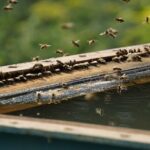Termites: Nature’s Eco-Engineers Unveiled

Imagine a world where tiny architects roam beneath our feet, constructing impressive fortresses with extraordinary precision. Welcome to the extraordinary realm of termites – nature’s hidden eco-engineers. These seemingly insignificant creatures, often underestimated and overlooked, hold the incredible power to shape entire ecosystems. Prepare to be amazed as we embark on a journey to unveil the remarkable world of termites as eco-engineers, exploring their invaluable contributions in fostering sustainability, combating climate change, and preserving the delicate balance of our planet’s natural habitats.
Termites as Eco-Engineers
Termites, those small and often underestimated creatures, possess an extraordinary talent for engineering that shapes our ecosystems. Through their tireless efforts, they modify and transform their surroundings, creating a ripple effect that impacts the entire natural world. From constructing intricate mounds and tunnels to decomposing organic matter, termites play a critical role in maintaining soil fertility, mitigating climate change, and fostering ecosystem resilience.
Digging Deep: Termites and the Ecosystem
Termites are regarded as some of the most important ecosystem engineers, utilizing their remarkable skills to manipulate their environment. They engage in a multitude of activities that significantly influence biodiversity and ecosystem functioning. By moving both organic and inorganic matter, termites bring about changes that are crucial for nutrient cycling, soil structure, hydrology, and even land management.
Termites are true bioturbation agents, altering the physical properties of the soil as they construct extensive networks of tunnels and runways. Their constant burrowing breaks up compacted soil, enhancing its ability to absorb and retain water. This process also aids in preventing soil erosion, making termites vital in areas prone to heavy rainfall or arid conditions.
Quote: “Termites, through their activities, profoundly impact the health and resilience of ecosystems, showcasing the power of nature’s engineering.”
The Hidden Treasure: Termites and Nutrient Cycling
One of the most significant roles termites play as eco-engineers is their ability to influence nutrient availability and distribution. Termites concentrate nutrients into their nests, enriching the soil around them. By doing so, they create resource hotspots, increasing the complexity of land management and altering resource patchiness in their environment.
This concentration of nutrients has far-reaching effects on the surrounding flora and fauna. It supports the growth of plants near termite colonies, making them more resilient and promoting biodiversity. Additionally, the decomposition of organic matter by termites releases essential nutrients back into the soil, fostering the overall health of the ecosystem.
Quote: “Termites, with their nutrient-cycling prowess, are the unsung champions of maintaining soil fertility and nourishing the delicate web of life.”
Scent of the Architects: Termites’ Communication and Coordination
Within the complex societies of termites, communication is key. They employ chemical signals called pheromones to coordinate their activities and behaviors, ensuring the efficient functioning of the colony. These invisible messages guide termites in tasks such as foraging for food, defending their nests, and building intricate structures.
Termites’ sophisticated communication systems allow them to respond rapidly to changes in their environment. They can adapt and modify their engineering efforts to suit prevailing conditions. This level of coordination is crucial for their survival, and it exemplifies the remarkable ways in which termites navigate their intricate social networks.
Quote: “Termites’ chemical conversations unite them as a force, demonstrating the astounding harmony in nature’s orchestra.”
Balancing Act: The Interplay between Termites and Predators
In any ecosystem, maintaining balance is vital, and termites are no exception. Despite their impressive engineering skills, termites are not without their predators. Ants, birds, amphibians, reptiles, and mammals form a natural regulatory force, keeping termite populations in check and preventing unchecked growth.
This delicate interplay between termites and their predators ensures that ecosystems remain in equilibrium. As predators feast on termites, they prevent exponential population growth, preserving the delicate balance between termites, their surrounding environments, and the larger web of life.
Quote: “The dance between termites and their predators preserves the delicate equilibrium necessary for thriving ecosystems.”
In conclusion, termites are eco-engineers of immense significance, their impact stretching far beyond their diminutive size. Their ability to modify and shape their environment through burrowing, nutrient-cycling, and chemical communication showcases their exceptional engineering prowess. By understanding and appreciating the vital roles these tiny architects play, we can inform conservation efforts and develop management strategies that prioritize their protection, ultimately safeguarding the health and resilience of our planet’s ecosystems.
Table: Termite Control Methods
| Termite Control Methods | Pros | Cons |
|---|---|---|
| Physical barriers (e.g., metal mesh) | Effective long-term solution | Expensive installation and maintenance |
| Baiting systems | Targeted approach | Slow-acting process |
| Chemical treatments | Quick elimination of termites | Potential environmental impact |
| Integrated pest management | Comprehensive and sustainable approach | Requires expertise and ongoing monitoring |
Note: The table showcases various methods for termite control, weighing their pros and cons to help inform decision-making.
Do you want to learn some fascinating Termite Mound Facts? These incredible structures built by termites can reach heights of up to 30 feet tall! You won’t believe the complex network of tunnels and chambers that exist inside these mounds. They serve as a fortress, protecting the termite colony from predators and providing a constant temperature and humidity for their survival. If you’re intrigued by these remarkable architectural wonders, dive deeper into the world of Termite Mound Facts by clicking here: Termite Mound Facts.

FAQ
Question 1
What is the role of termites in shaping ecosystems?
Answer: Termites, as ecosystem engineers, manipulate the ecosystem by building complex mounds and nests, moving organic and inorganic matter, acting as bioturbation agents, building tunnels and runways, and decomposing macrofauna. Their activities have a significant impact on biodiversity, soil structure and hydrology, nutrient availability, and organic matter decomposition.
Question 2
How do termites influence resource distribution in ecosystems?
Answer: Termites concentrate nutrients into their nest structures, increasing the complexity of land management and resource patchiness. This affects the distribution of resources in ecosystems and plays a role in nutrient cycling and availability.
Question 3
How do termites communicate with each other?
Answer: Termites communicate through chemical signals called pheromones. These pheromones help them coordinate their activities and behaviors within the colony.
Question 4
What are some methods for controlling termite populations?
Answer: Termite populations can be controlled through various methods such as using physical barriers, baiting systems, or chemical treatments. These methods help prevent damage to structures and mitigate the impact of termites on ecosystems.
Question 5
Do termites have natural predators?
Answer: Yes, termites have natural predators including ants, birds, amphibians, reptiles, and mammals. These predators help regulate termite populations and maintain balance in the ecosystem.
json
{
"@context": "https://schema.org",
"@type": "FAQPage",
"mainEntity": [
{
"@type": "Question",
"name": "What is the role of termites in shaping ecosystems?",
"acceptedAnswer": {
"@type": "Answer",
"text": "Termites, as ecosystem engineers, manipulate the ecosystem by building complex mounds and nests, moving organic and inorganic matter, acting as bioturbation agents, building tunnels and runways, and decomposing macrofauna. Their activities have a significant impact on biodiversity, soil structure and hydrology, nutrient availability, and organic matter decomposition."
}
},
{
"@type": "Question",
"name": "How do termites influence resource distribution in ecosystems?",
"acceptedAnswer": {
"@type": "Answer",
"text": "Termites concentrate nutrients into their nest structures, increasing the complexity of land management and resource patchiness. This affects the distribution of resources in ecosystems and plays a role in nutrient cycling and availability."
}
},
{
"@type": "Question",
"name": "How do termites communicate with each other?",
"acceptedAnswer": {
"@type": "Answer",
"text": "Termites communicate through chemical signals called pheromones. These pheromones help them coordinate their activities and behaviors within the colony."
}
},
{
"@type": "Question",
"name": "What are some methods for controlling termite populations?",
"acceptedAnswer": {
"@type": "Answer",
"text": "Termite populations can be controlled through various methods such as using physical barriers, baiting systems, or chemical treatments. These methods help prevent damage to structures and mitigate the impact of termites on ecosystems."
}
},
{
"@type": "Question",
"name": "Do termites have natural predators?",
"acceptedAnswer": {
"@type": "Answer",
"text": "Yes, termites have natural predators including ants, birds, amphibians, reptiles, and mammals. These predators help regulate termite populations and maintain balance in the ecosystem."
}
}
]
}
- Unraveling Einstein’s Legacy: Who Inherited His Genius? - July 14, 2025
- Unlock Einstein’s Family Tree: Bernhard Caesar & Untold Stories - July 14, 2025
- Unveiling Bernhard Caesar Einstein: His Life & Albert Einstein’s Legacy - July 14, 2025
















